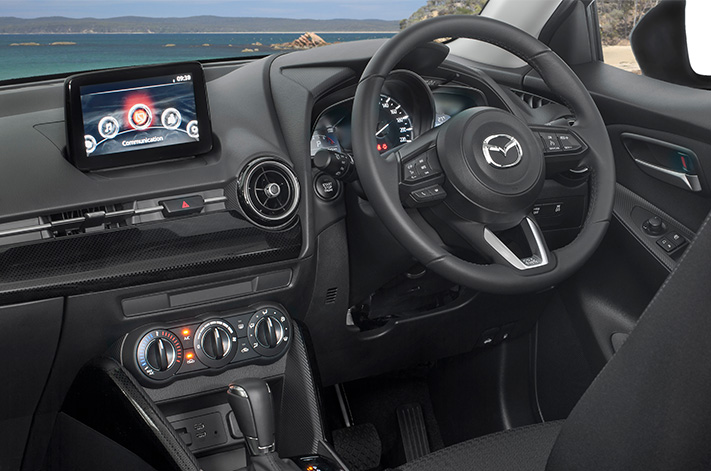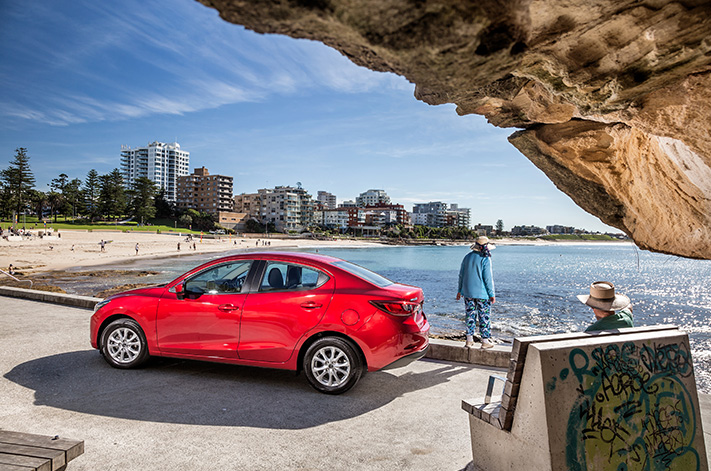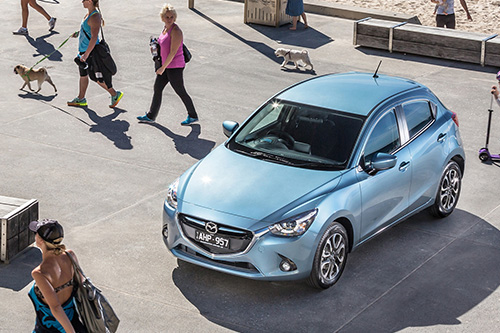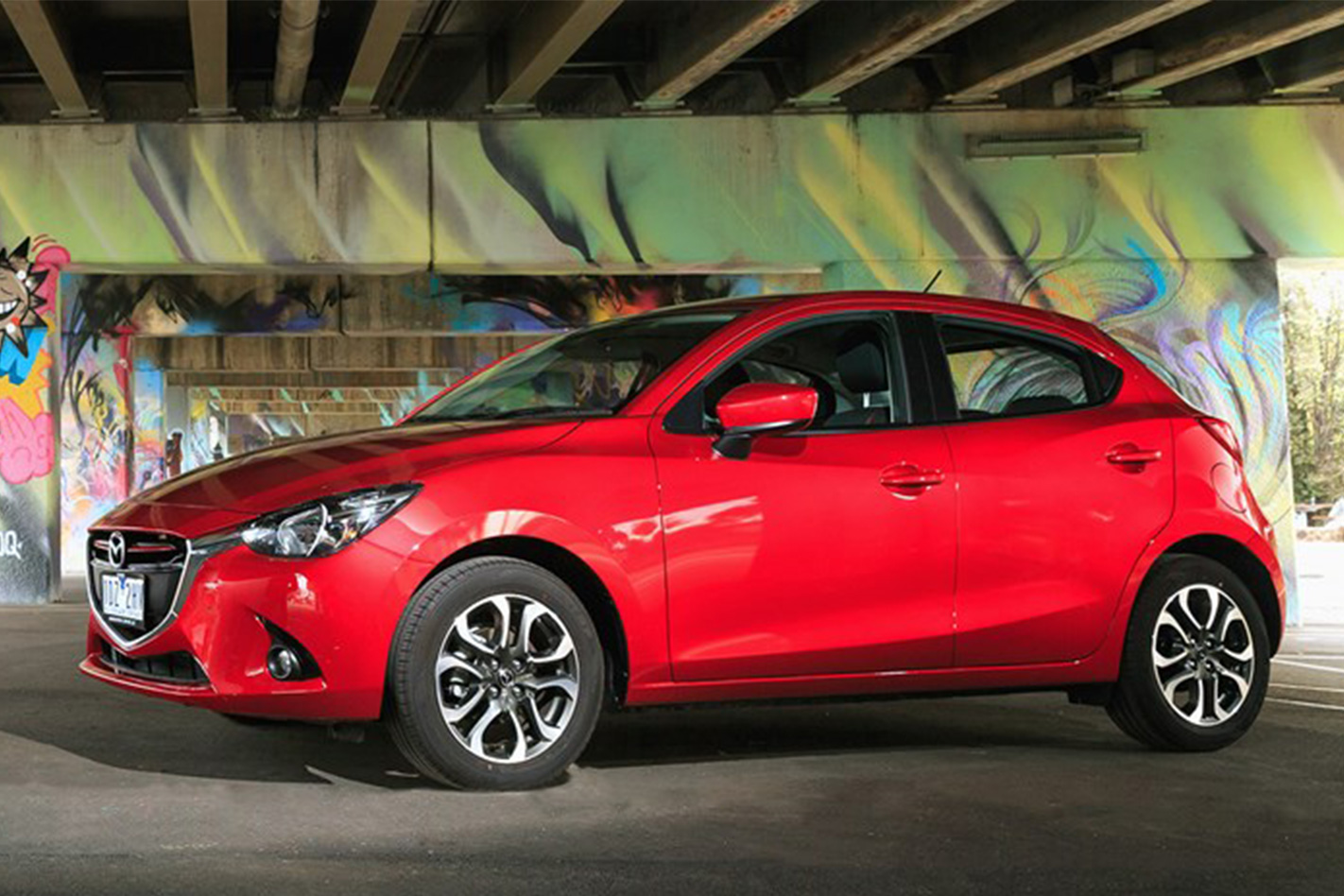The Mazda 2 is one of those rare light cars that provide a mix of good value and driver enjoyment. It looks good and has a premium feel inside while delivering plenty of power, and it is equipped with smart city braking as standard. Prices start at $14,990 and it’s available in four variants with five-door hatch and sedan body styles all powered by a 1.5-litre engine coupled with either six-speed manual or six-speed automatic transmissions.
Variants
The Mazda 2 comes in four model grades; the Neo, Maxx, GT and Genki (compare these specs here). The entry-level Neo provides excellent value and while it’s missing a few features, including a display screen and reversing camera, it does come with automatic city braking.
The Maxx introduces a more powerful 87kW/141Nm version of the 1.5-litre engine, DAB+ digital radio and infotainment apps displayed on a 7.0-inch floating screen with reverse camera and 15-inch alloy wheels. The steering wheel and gear-lever handle are trimmed in leather, and your music comes from six speakers rather than four.

The Genki adds leather interior, satellite navigation, dusk-sensing LED headlamps, daytime running lights, auto windscreen wipers, climate-control air conditioning, 16-inch alloys inches, blind-spot monitoring and a rear cross-traffic alert.
The range-topping GT is essentially a Genki with white seat and cabin trim. It comes in hatch and sedan body styles with just the six-speed manual gearbox.
- Neo hatch/sedan, manual – $14,990
- Neo hatch/sedan, auto – $16,990
- Maxx hatch/sedan, manual – $17,690
- Maxx hatch/sedan, auto – $19,690
- Genki hatch, manual – $20,690
- Genki hatch, auto – $22,690
- GT hatch/sedan, manual – $21,680
The Maxx is an excellent choice with plenty of features for the sub-$20,000 price. The perky manual transmission feels sporty and makes the 2 one of the most enjoyable cars to drive for its size and price. That said, if you are clutch adverse, the six-speed automatic transmission is pretty good too if not as fun. The interior has a premium feel with quality fabric seats that don’t make you yearn for the leather in the upper-spec models. The sedan’s boot holds 440-litres compared to the hatchback’s 250-litres and is arguably the better looking of the two.

Available options
Equipment you may want to add to up-spec the Maxx include:
- Metallic paint – $300
- Front parking sensors – $635
- Satellite navigation – $701.84
- Welcome illumination in the foot well – $259.06
- Alloy pedal covers – $306.38 (auto)/$337.72 (manual)
The Maxx is well-appointed enough to not require further bling. One thing all Mazdas lack is Apple CarPlay/Android Auto connectivity, which makes the satellite navigation pack a worthy addition while still keeping your purchase price around $3200 less than the GT sedan.
The Mazda 2 is consistently one of the bestselling cars in its segment, which includes compelling rivals such as the Volkswagen Polo. The little Japanese hatch or sedan proves that driving a city car doesn’t have to be boring, and has funky good looks to boot.
If you are looking to add one to your garage, here is everything you need to know about the price, standard features, pros and cons, and which version we would recommend.

Price and Features
Every Mazda 2 comes with cruise control, power windows and an AM/FM radio with a single-disc CD player and USB input. Audio controls on the steering wheel and hands-free Bluetooth phone and audio connectivity, push-button keyless start, and a tilt and reach adjustable steering column, along with rear parking sensors, and six airbags. An option available on all Mazda 2s for around $400 is Smart City Brake Support, a form of automatic emergency braking that operates at speeds below 30km/h. Every Mazda 2 carries a three-year, unlimited kilometre warranty.
Pricing starts from $14,990 for the entry-level Neo with a manual gearbox, $17,690 for the Maxx, and $20,690 for the top of the line Genki. Choosing an automatic gearbox adds $2000.
Pros and cons
The Mazda 2 looks good, feels nice inside, and is more fun to drive than most city cars. Its 1.5-litre engine is very easy on fuel and delivers plenty of power. Strong retained values and a 12-month service interval help make it a smart choice.
The list of cons for this car is rather short given Mazda added cruise control to the least costly models. Perhaps squinting at the tiny tachometer in less expensive models (upper spec grades have a different instrument design) could be annoying if you want to know what the engine is doing. The spare tyre is a space saver, and its 80km/h recommended top speed could bother you if you get a flat far from home. But for a car intended mainly for city use, it’s a defensible choice because it frees up some boot space.
The one to get
The Mazda 2 Maxx, in either hatch or sedan, is our pick of the line-up. Both bring desirable features such as alloy wheels, a reversing camera and a 7.0-inch touchscreen loaded with the Pandora, Stitcher and Aha internet radio apps. Its steering wheel and gear-lever handle are trimmed in leather. Wheels are made from aluminium alloy and look nicer than the plastic-trimmed steel wheels on the least costly model, the Mazda 2 Neo. However, the Neo is an appealing base model that represents very good value.
QUESTION – MARTIN: My wife has a Mazda 2, and we are looking to buy another new car. At the dealer we looked at the current Mazda 2 Genki small hatch as well as the Mazda CX-3 Maxx small SUV.
Is there another car we should look at? We drive mainly in the city and a little country from time to time. Mileage would be approximately 10,000km per year.
The Mazdas appeal to us because they have lots of features and we like our Mazda 2.
BUDGET: $30,000
RESPONSE – SAMANTHA: The Mazda 2 is a fabulous city car, and within your budget you can load up on the features and spec. The Genki model you looked at ($20,690) is the top of the range and does come with a lot of standard equipment. It’s an excellent option.
The CX-3 Maxx ($22,390) is also an excellent vehicle, with a higher driving position and slightly easier access up front than the diminutive Mazda 2, however it is, in fact, based on the Mazda 2 so the extra money doesn’t get you much more in the way of cabin room or cargo space, and the mid-spec Maxx model grade doesn’t have as much equipment as the top-spec Mazda 2 Genki.

It’s also worth noting that as the CX-3 has a larger engine than the Mazda 2 (2.0-litre vs 1.5-litre) it will have some more costs associated with it; not just the buying price, but also slightly higher running costs such as fuel consumption, as well as tyres etc., so be sure an SUV is necessary for your needs.
If you are looking at a slightly larger car than the Mazda 2 light hatch, you may want to consider the Mazda 3 instead of the CX-3. The Mazda 3 Maxx Safety is the pick ($25,890). Other small hatchbacks worth looking at outside the Mazda brand include the Ford Focus (Trend, or a demo Titanium), and the Hyundai i30 Active X ($22,590).

Should you be happy with the Mazda 2’s size, other cars in its segment to consider would be the Volkswagen Polo TSI Comfortline ($21,190) and the Renault Clio Dynamique ($25,000). Both will be slightly more expensive to service than the Mazda, but have fun and frugal 1.2-litre turbo engines with automated gearboxes, and a host of included options. Each has a different and unique seating position – be sure to test drive them and see what suits.